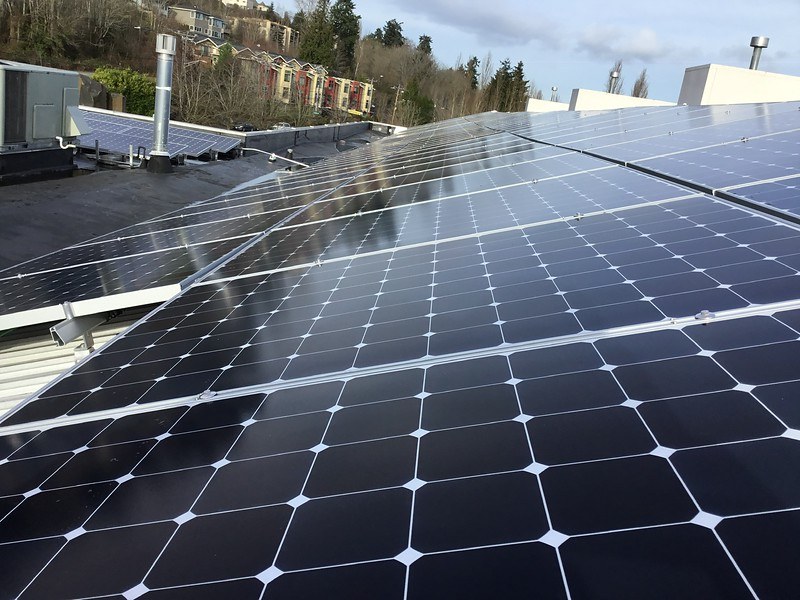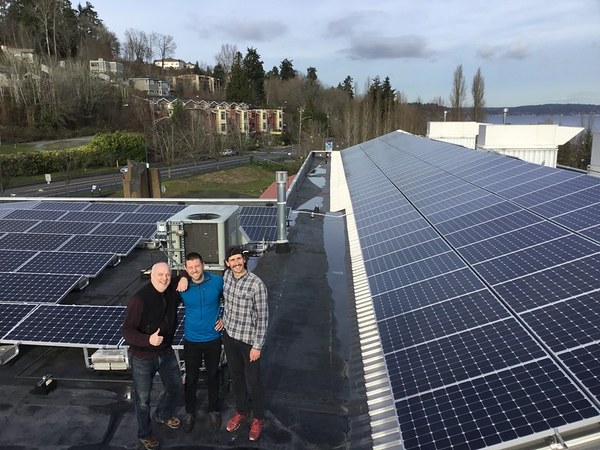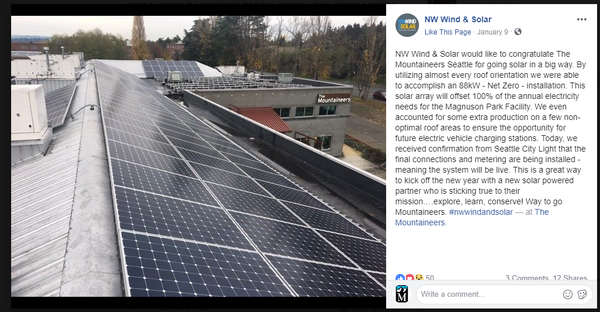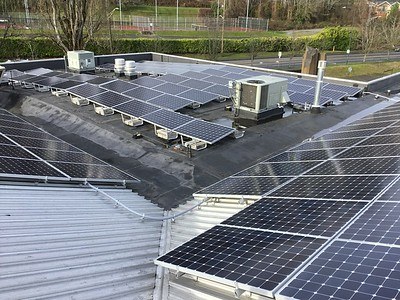
With the flick of a switch, our building underwent a transformation. What had been a normal Thursday at the Seattle Program Center - with staff bustling about while members perused our bookstore - changed in an instant. On January 17 our new solar panels were switched on and sunlight was converted into resource-saving energy that powered all the essential mechanisms for running the program center.
When we moved into our new building in 2009, a solar power installation wasn’t something we imagined in our future. Changes in technology and availability brought this idea closer to reality, but, most importantly, two significant donors brought the idea to fruition. In December 2017, Charlie and Carol Michel approached us with an idea to install a full solar power system at Seattle Program Center. After a little over a year and thanks to a generous donation from the Michels , our friends at NW Wind and Solar installed a solar array on our roof to meet all the electricity needs of the Program Center. We could not be more grateful for the Michels partnership and their incredibly meaningful gift that provided half the funding for this important project!

Our building has 271 ‘modules’ (panels) mounted on a racking system on our roof. Collectively, the panels are called a solar array. Our solar array has a peak power generation capacity of 88.62 kW, and is projected to produce more than enough electricity to meet our building’s annual needs. The energy produced by the panels is transported to 5 SolarEdge Inverters with DC (direct current) optimizers, which take the DC output and transforms it into 240V AC (alternating current).
We suspect these figures may sound like meaningless jargon to many readers.
Let’s break down what it really means:
Our system has a capacity to generate up to 88.62 kW of electricity while the sun is shining. The panels generate photovoltaic (PV) energy directly from the sun, which is turned into AC electricity through inverters. Because we receive variable amounts of sunlight in Washington, sometimes we create a lot of electricity and achieve full capacity, and other times we create less electricity and need to supplement our usage from external resources. That’s why our system is patched into Seattle City Light’s grid. When we create more electricity than we’re using, the excess electricity is channeled into the grid and SCL credits our account for the amount we put back. When our system isn’t creating enough electricity, it pulls energy from the grid and debits our SCL account. This win-win partnership allows us the freedom to create power from a sustainable, renewable resource, and provides us with the stability and consistency to keep our offices and programs open no matter the weather.
For by-the-minute updates on how much energy we’re currently generating, and have generated since our array came online, you can visit our account page at SolarEdge. We’ve also installed a repurposed television in our lobby to display the real-time data.
In addition to the amount of energy our array is generating, solar allows us more independence from other, less sustainable electricity sources, including hydropower, natural gas, and coal. The Mountaineers Program Center is served by Seattle City Light (SCL) and about half of SCL’s power comes from two large, local hydropower projects: the Skagit and Boundary Hydroelectric Projects. Another 40% comes from a variety of smaller hydropower projects, and the final 10% from a variety of other sources. While hydropower is a low carbon source of energy, it is not without impacts to aquatic ecosystems such as salmon habitat. Diversifying our renewable energy sources beyond hydropower and increasing conservation to reduce energy demand leads to a more sustainable energy future.
Taking the broader regional perspective of the Western Interconnection, the power grid that serves the Western United States, we are still overly reliant on fossil fuel-based energy resources. When Seattle joins the Western Energy Imbalance Market in 2020, it will further improve opportunities to integrate renewable energy resources throughout the regional grid. As fossil fuel resources, including coal and natural gas, are phased out as outlined in Washington State’s mandate for 100% clean energy (recently-passed Senate Bill 5116), the Program Center's solar PV system is projected to help reduce carbon dioxide emissions by 156 metric tons per year.
In 2017, when we began developing our new strategic plan (Vision 2022) with extensive feedback from our community, one of our 3 strategic priorities was to ‘Advocate for Wild Places’. By going solar, we are providing a new source of energy that is valuable to the regional grid. Our new solar panel installation directly responds to our strategic priority for resource protection and has inspired us into a new phase of thinking of other ways we can reduce our footprint to get the most from our solar array.

THE BIG PICTURE
In addition to supporting our strategic priority of advocating for our wild places, this project is saving us money. NW Wind and Solar predicts savings around $10,000 annually on energy bills. That’s $10,000 each year we can put somewhere else: into our programming, volunteers, conservation and advocacy, and strategic investments. In 10 years, we can expect to save nearly $100,000.
We continue to evaluate other opportunities to reduce the energy used by our buildings. Making more energy efficient choices in lighting will allow us to use our solar power to its fullest capacity by putting more energy back into the grid. Part of the installation of this project included a few extra panels on non-optimal roof surfaces, so that in the coming years we might consider installing a Electric Vehicle (EV) charging station or two. Thanks again to the Michels, we’ve installed LED lights in our Mountaineers Books warehouse, and are looking into improving other buildings as well.
Additionally, Mountaineers Books has been focused on sustainable printing practices for years and is prioritizing sustainable printing practices more than ever. Over time, we’ve increased printing on Forest Stewardship Council (FSC) certified paper (for overseas printing) and recycled paper (for domestic printing). Most recently, 100% of the titles in our Fall 2018 and Spring 2019 release schedule were were printed on FSC or recycled paper. This is a huge achievement after hovering at the 85%-95% level for years, and we look forward to continuing to keep this a priority at Mountaineers Books.
INTERESTED IN SOLAR?
Solar has the potential to increase sustainability and save money while reducing greenhouse gas emissions. If you’re inspired to consider how solar or other types of renewable energy might play into your life, we’ve included a few resources below on installing a solar power system and determining your energy consumption.
- Calculating your home’s energy use is a great way to begin determining what kind of system might work for you. Here’s Appalachian Power’s Home Energy Calculator, an interactive webpage helps you to identify the things in your house that use energy and how much they use.
- Currently, Washington State offers significant Tax Credits and Incentives for businesses and individuals who install a solar power system.
- Most local energy companies offer green energy programs, which allow customers to pay a small overage each month to support the energy company’s ability to purchase Renewable Energy Credits (RECs). SCL’s program is called Green Up, and it is convenient and easy to register. This is a great option if you are a renter, or if wind, solar, or geothermal energy is otherwise not an option for you to install on-site.

Add a comment
Log in to add comments.Very impressive system - kudos to all those involved!
We went PV solar at our farm ~10 years ago and updated our passive solar pre-heat system. A pico hydro plan for our small stream in the ravine to power our pasture fence is yet in the dreaming stage. Hurrah to Program Center efforts and welcome to the family.
That is a beautiful system; thanks to Charlie and Carol Michel and everyone involved. The impact is greater than just offsetting hydro generation. When generation from the Skagit is not used for City of Seattle load, it can be sold to offset dirty generation elsewhere.
 The Mountaineers
The Mountaineers